Strictly speaking the point of this trip was neither, and didn't include any camping at all, as the goal was to attend a family reunion, for which hotel accommodations were arranged. However, some family members hit upon the idea of arranging a week's worth of camping in Peninusular State Park, Door County, WI, in front of the Green Bay reunion. Not being as organized, me & mine managed to meet up with them Wednesday night, and spend Thursday and Friday with them exploring the county. (Though we left Tuesday evening, skating into Indiana Dunes State park at 10:45pm, 15 minutes before it closed, we spent much of wednesday at the Chicago Botanic Gardens, which I enjoyed, but felt would be of little interest.)
Unlike other family members, who presumeably spent most of their memory or film and energy photographing distant cousins, I shot wildflowers instead at the various State Parks, some of which I show below. I am considerably indebted to my copyright ’68 Peterson Field Guides—Wildflowers of Northeastern/Northcentral North America for assistance in identifying many of these flowers, though of course any errors (and I'm sure there are plenty) are mine.
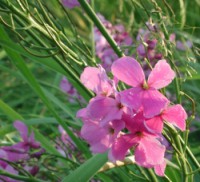
Strictly speaking Dames’ Rocket is not a native species, but an Asian one; but it is so entrenched in the american consciousness as such that its prolific seeds are often included in wildflower mixes. Unlike the five petaled phlox which it closely resembles it blooms in spring (rather than summer) in sunny or part sunny sites. This backlit specimen was taken on a scenic lookout late in the day on the shores of Lake Michigan—on Wednesday evening, on our way to the rondevous.
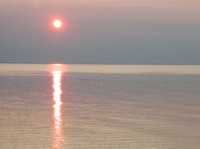
The closest thing to a vacation picture I shot. I spent more time than my family really wanted whining that I'd left my watercolors home, and my efforts to capture the subtlety of the colors of this in colored pencil were dismal. While family members skipped stones, and conversed on a bench nearby, I sketched, and finally photographed, the sunset at Welcker's Point, Peninsula State park.
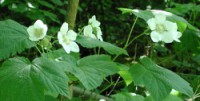
One of my SiL's interests is lighthouses, so we went to see Cana Island lighthouse; low lake levels meant the crossing over a rocky strip was dry. We were all intrigued by the many bushes with large, palmate leaves (rather like grape leaves) and white, five petaled flowers. Speculation was rife as to whether the plant belonged to the rose or blackberry family. I asked the gatehousekeeper on the tiny island about it, and she said the plants were thimbleberries, and they had a workshop on making thimbleberry jam later in the season. Also that they grew exclusively on the lake, rather than bay, side of the island. Didn't find a reference to thimbleberry, but it does mention thimbleweed; however, the leaves of that are more deeply cut. At any rate, the flowers closely resemble that of
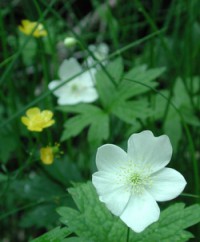
Canada Anemone, which we saw in the UP. (It also had Thimbleberries, and no lake for miles around.) Both the thimble weed and the canada anemone are in the anemone family; strictly speaking, those white things are sepals, not petals. Ranuculus, or buttercups, are in the background. Shot at van Riper.

I photographed this pretty, large (3”) bunchberry on the little path that led from our campsite (No. 31) to the service road. If it reminds of flowering dogwood, it's for a good reason: they're related. Like the canada anemone, the white parts are actually bracts.
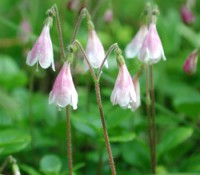
This aptly named twinflower was a find in Whitefish state park. While everyone else sat on the beach, basked in the sun or swam in the water, Rob and I escaped to the (sometimes shaded) trails. A member of the honeysuckle family, it's supposed to be fragrant, though I didn't notice. On this little hike, besides the observation tower, we saw fields of wildflowers, notably hawkweed, daisy fleabane, and many of those multiply headed yellow dandelion like flowers of which wild lettuces and sow-thistles are common examples.
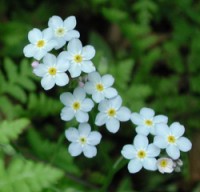
There are a number of forget-me-nots, some of which are aliens, and some not. This one looked remarkably like the specimen I have in my garden. Though they do well in shade (note the lush fern on the left) even some of the wild woodland ones suffered from the mildrew that rendered my patch a rotten, black mess. The little trail sign suggested the name came from a knight who fell into the water and drowned, begging his love to “forget me not!”. This specimen was shot on the Old Wagon Trail in van Riper, UP.
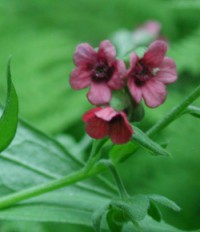
This purple gerardia was another dainty woodland specimen, with blossoms no more than half an inch long, and quite probably less. I shot it on the way back from Weborg marsh, on my way back to the campsite: Sunset Trail to Bluff, to the “Vita” course (I couldn't do any of the overhead arm-to-arm ladder exercise...) in Peninsula state park.
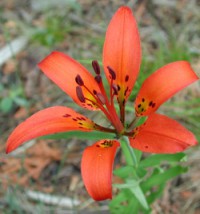
This is a native specimen of true lily, leopard spotted, and pretty dramatic, as it's some three inches or so across. I came across this bonus while on a hike to find blue flags and lady's slippers, both reputed to be abundent on the Hemlock trail, shortly before I reached the Weborg Marsh (where I hoped to see lady slippers) in Peninsular state park.
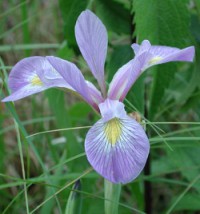
Ah, the flower I came to see. In fact, I was discover a great big patch of them along the roadside (US-41) that divides van Riper. Though found in Wisconsin (obviously), they are Michigan's state wildflower. This specimen was growing in Weborg Marsh, from the Hemlock trail side, located towards the south end of Peninsula State Park (near the entrance). The boggy conditions (my feet squelched because I was bad and stepped off the trail to get closer) meant lots of mosquitos.
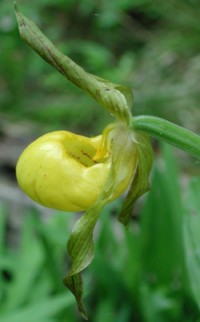
As we were leaving Cana Island Lighthouse I thought I spotted a ladyslipper along the road. I got just a glimpse as we were turning, and as there were three cars caravaning together, and children highly desirous of visiting the beach at our next destination (Whitefish Dunes) there was no time to stop. Next morning (Friday) I set out in search on Peninula's many trails. Nor were any to be found on the official trail for lady slippers at Peninsular, the Hemlock Trail, though I did see the wood lily and blue flag. However, I have a talent for getting lost and went the wrong way on the Sunset Trail, which intersects Hemlock at Weborg marsh—instead of heading north, back to South Nicolet Bay where we were camping, I went south, where a short, graveled leg of this trail curls around the park entrance. And there they were, right by the edge of the wide, bike and wheelchair accessible path. Success at last!

I'm slowly branching out from single, closeup shots of flowers to slightly larger views as this flowery meadow framed by vetch (probably cowvetch, another alien) and goats beard. I saw fields of vetch, hawkweed, daisies and others (sow-thistles, probably). Wonderful. Probably shot on the Old Wagon Trail, in one of the meadow clearings van Riper State park.
These pictures were shot at various places in Door county, WI, (most at Peninusla State Park, some also at Cana Island lighthouse and Whitefish Dunes state park or at van Riper state park in the UP. Peninsula state park, where we stayed, had some wonderful trails and beautiful flowers, though there is a great deal of poison ivy, so it behooves you to learn to recognize this somewhat variable native plant. Wisconsin state parks boast excellent online documentation, including complete maps of the trails I wandered over and lost my self on.
Van Riper, particularly the walking trails, were amply populated with hordes of mosquitos—even with long sleeves, long pants and bug spray they were still a problem on the damp-rocked trails (I should note, this was during the end of June on a 90deg plus day, perfect mosquito weather). The Old Wagon trail, which I did myself, unfortunately paralleled the highway for some of its length. The slippery rocks and hills on the northern loop of the River Trail, which all four of us did together made that hike moderately vigorous.
Unless otherwise noted, text, image and objects depicted therein copyright 1996--present sylvus tarn.
Sylvus Tarn